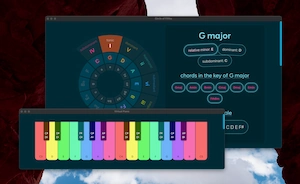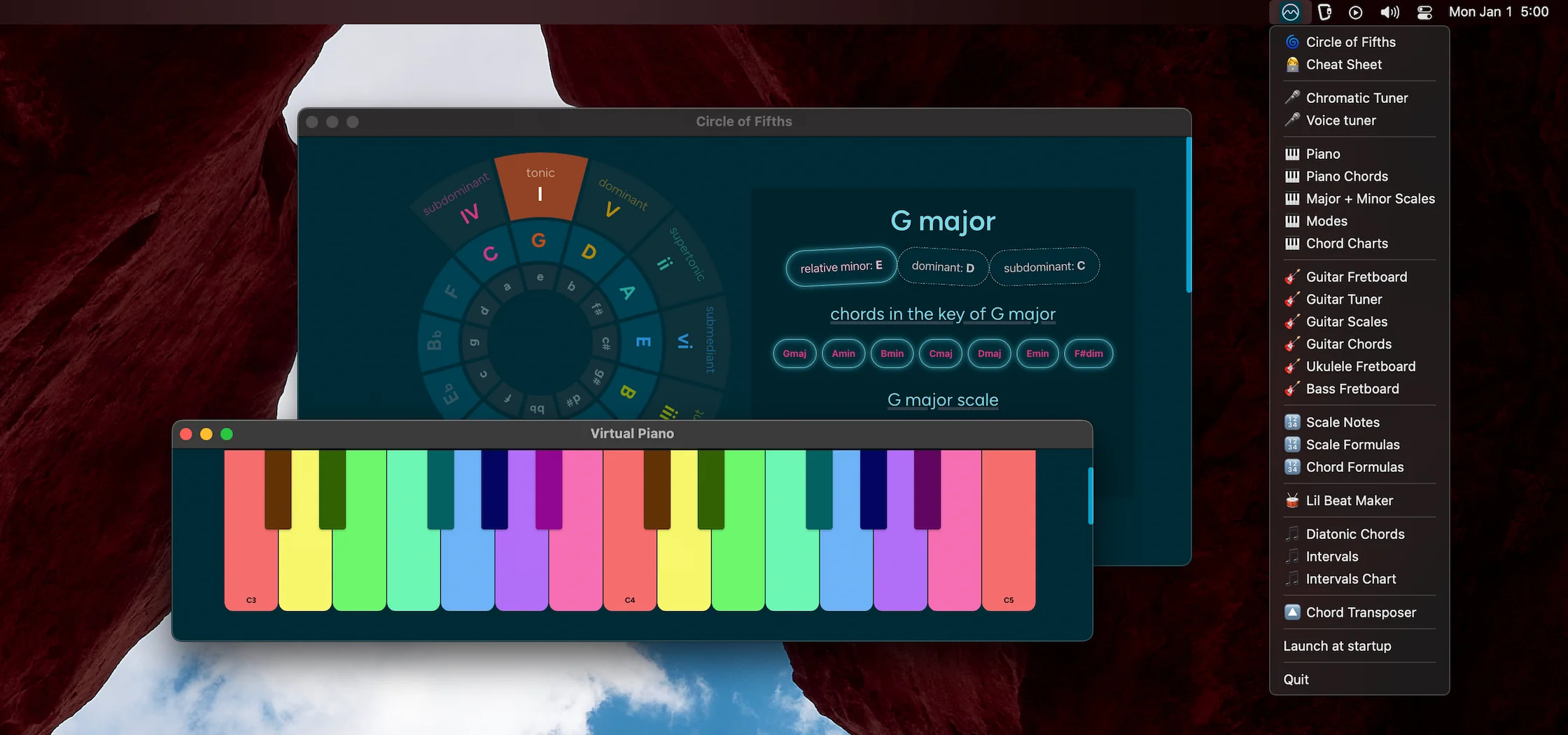Music Theory Cheat Sheet: Keys, Scales, Chords, Notes & Intervals
✨🎵✨ An interactive music theory cheat sheet to get all you need at a
glance:
keys, scales, modes, notes, chords and
intervals.
Just select a major or minor key and you'll get the notes of
the scale, scale formula, the relative major or minor, modal scales for that
key, scale degrees/intervals, the key signature, the diatonic chords, the
diatonic 7th chords, the chord functions and the relationship with other keys
on the Circle of Fifths (aka circle of
fourth, when going counter-clockwise).
→ For more reference on chords and scales, you may like this
scale formula chart,
chord formula chart and this
list of chords.
-
C♯
D♭ - D
-
D♯
E♭ - E
- F
-
F♯
G♭ - G
-
G♯
A♭ - A
-
A♯
B♭ - B
-
C♯
D♭ - D
-
D♯
E♭ - E
- F
-
F♯
G♭ - G
-
G♯
A♭ - A
-
A♯
B♭ - B
C Major
C Major Scale
steps: whole whole half whole whole whole half whole half whole whole half whole whole
relative minor → A Minor
C Harmonic Minor Scale
C Melodic Minor Scale
relative major → A Major
Modes of the Major Scale
C
C Major Pentatonic Scale
C Major Blues Scale
C Minor Pentatonic Scale
C Minor Blues Scale
C Major Scale Degrees & Intervals
- 1- Tonic: C → Unison
- 2- Supertonic: D → Major 2nd
- 3- Mediant: E → Major 3rd
- 4- Subdominant: F → Perfect 4th
- 5- Dominant: G → Perfect 5th
- 6- Submediant: A → Major 6th
- 7- Leading Tone: B → Major 7th
- 8/1- Octave/Tonic: C → Perfect 8th
C Major Key Signature & Notation
Theoretical Scale
The scale is a theoretical scale that contains double accidentals. For this reason, that scale is not used often. The enharmonic equivalent scale is used instead most of the time.
C Major Diatonic Chords
| I | ii | iii | IV | V | vi | vii° |
|---|---|---|---|---|---|---|
|
C
C E G |
Dm
D F A |
Em
E G B |
F
|
G
|
Am
|
B°
|
C Major Diatonic 7th Chords
| IM7 | iim7 | iiim7 | IVM7 | V7 | vim7 | viiø7 |
|---|---|---|---|---|---|---|
|
C
C E G B |
Dm7
D F A C |
Em
E G B D |
F
F A C E |
G
|
Am7
|
Bø7
|
- the tonic chords are chords I, iii & vi
- the subdominant chords are chords IV & ii
- the dominant chords are chords V & vii°
| i | ii° | III | iv | v | VI | VII |
|---|---|---|---|---|---|---|
|
C
C Eb G |
D°
D F Ab |
Eb
Eb G Bb |
Fm
|
Gm
|
A
|
B
|
C Natural Minor Diatonic 7th Chords
| im7 | iiø7 | IIIM7 | ivm7 | vm7 | VIM7 | vii7 |
|---|---|---|---|---|---|---|
|
C
C Eb G Bb |
Dm7
D F Ab C |
Em
E G B D |
F
F A C E |
G
|
AM7
|
B7
|
- the tonic chords are chords i & III
- the subdominant chords are chords iv, VI & ii°
- the dominant chords are chords V, v, VII & vii°
The harmonic minor scale has a raised 7th scale degree compared to the natural minor scale, which makes that 7th scale degree into a leading tone and makes the V chord a major chord. In functional harmony, that V chord from the harmonic minor scale is used most often because the leading tone gives a stronger sense of wanting to be resolved to the tonic.
C Major on the Circle of Fifths
Common C Chords
click to hear the different chords
Order of sharps
F C G D A E B
Order of flats
B E A D G C F
Chromatic Scale
C-D♭-D-E♭-E-F-G♭-G-A♭-A-B♭-B
alternative enharmonic spelling:
C-C♯-D-D♯-E-F-F♯-G-G♯-A-A♯-B
Solfège syllables
Do Re Mi Fa So(l) La Ti Do
Accidentals
Double Sharp: 𝄪
Sharp: ♯
Natural: ♮
Flat: ♭
Double Flat: ♭♭
Chord Symbols
Major: M, maj, △
Minor: m, min, -
Dominant 7th: 7, dom7
Diminished: dim, °
Half-diminished: m7b5, ø
Augmented: aug, +



